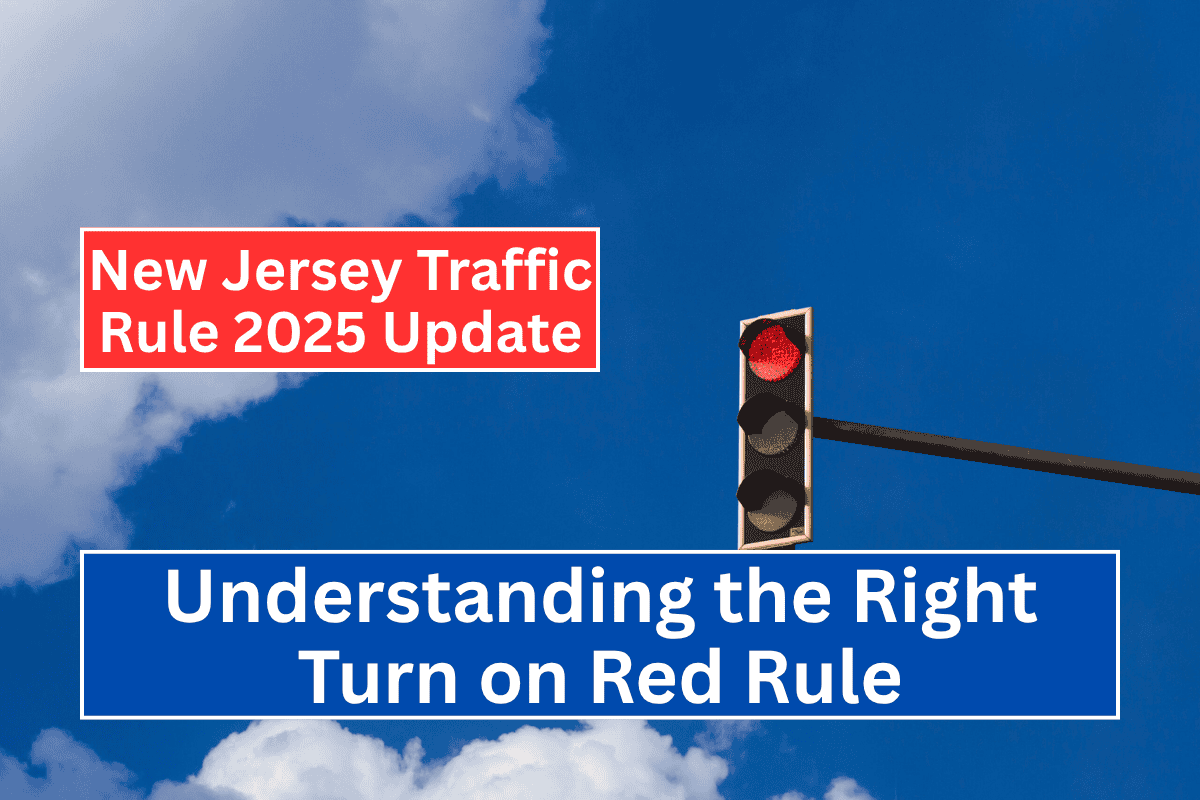New Jersey’s traffic laws are vital for maintaining road safety and efficiency. Following these laws ensures smoother traffic flow, reduces accidents, and helps drivers reach their destinations safely.
One key rule that all drivers should understand is the right turn on red. As road rules evolve, it’s crucial for drivers to stay updated and continue practicing safe driving habits.
What Is the Right Turn on Red Rule in New Jersey?
In New Jersey, drivers are generally allowed to make a right turn at a red light unless there is a sign explicitly prohibiting it.
According to New Jersey Statutes Annotated (N.J.S.A. 39:4-115), before making a right turn on red, the driver must come to a complete stop, look both ways, and yield to both pedestrians and oncoming traffic. Drivers should make sure the way is clear and proceed cautiously.
This rule is designed to keep traffic moving while still ensuring pedestrian safety. However, drivers should always be cautious when making a right turn on red, as pedestrians, cyclists, and other vehicles may be in the vicinity.
The Importance of Yielding the Right of Way
Yielding the right of way is an essential traffic concept that prevents accidents and maintains smooth traffic. The right of way determines who gets to move first in situations like intersections, pedestrian crossings, or when turning.
For instance, if an emergency vehicle such as an ambulance or fire truck is approaching, drivers must immediately pull over and give way. Similarly, buses and postal vehicles also have the right of way when re-entering traffic from a stop.
At intersections, when two vehicles approach at the same time, the vehicle on the right has the right of way. Understanding these rules and complying with them helps prevent collisions and keeps the road safer for everyone.
Pedestrian Safety and Crosswalks
Pedestrians always have the right of way when crossing the street at marked crosswalks. In New Jersey, drivers who fail to yield to pedestrians can face fines and penalties.
For example, failing to yield at a crosswalk can result in fines ranging from $85 for not yielding at an intersection to $200 for failing to stop at a stop sign. In addition to the fines, offenders may face up to 15 days in jail, community service, and points on their driving record.
Pedestrian accidents are especially dangerous because of the vulnerable nature of pedestrians. Drivers must remain vigilant, especially in areas where pedestrians are expected to cross.
Right of Way at Intersections
Intersections are common places for accidents. To avoid collisions, it’s essential to know and follow the right-of-way rules. At a four-way stop, the vehicle that arrives first has the right of way.
If two cars reach an intersection at the same time, the vehicle on the right goes first. Drivers must also yield to traffic when facing a yield sign and wait until it’s clear to proceed.
When turning left at an intersection, drivers must wait for oncoming traffic and pedestrians to clear before making the turn. Failing to yield in such situations can result in accidents.
Roundabouts and Traffic Circles
Roundabouts or traffic circles require special attention. When entering a roundabout, drivers must yield to traffic already inside the circle. Vehicles on the higher-traffic road typically have the right of way, and those entering from a lower-traffic road must wait until it’s clear to enter.
Specific Rules for Major Roadways
On major highways, turnpikes, and expressways, drivers must be aware of the rules when entering and exiting these high-traffic roads. For example, drivers entering a highway must yield to vehicles already on the highway and match the traffic flow speed. This is crucial for maintaining smooth traffic and preventing accidents.
Following Right of Way Guidelines
Following right-of-way rules ensures that traffic moves smoothly and safely. Drivers should always yield to pedestrians at crosswalks, avoid blocking bike lanes, and follow intersection rules to reduce the risk of accidents.
In situations where both vehicles arrive at the same intersection at the same time, the vehicle on the right has the right of way, and it’s essential to always yield to pedestrians, cyclists, and other road users.
Jaywalking and Parking Lot Safety
Jaywalking is another issue that can complicate traffic flow and safety. Pedestrians who cross the street without using crosswalks or fail to pay attention while texting can cause accidents. In parking lots, both drivers and pedestrians must be vigilant to prevent accidents.
Drivers should yield to pedestrians in crosswalks and always check for pedestrians when backing out of parking spaces.
Consequences of Failing to Observe Right of Way
Failure to follow the right-of-way rules can lead to accidents, and drivers may be cited by police. If a driver is found at fault, they could face fines, points on their driving record, and possibly higher insurance premiums. Pedestrians can also face fines if they cause accidents by jaywalking or crossing the road illegally.
If an accident occurs, it is essential to gather evidence, such as photos, witness statements, and police reports, to help determine liability. If you are involved in an accident where the right of way was violated, consulting with a personal injury attorney may help ensure that you receive compensation for any damages, medical bills, or lost wages.
Compensation for Right of Way Violations
Victims of right-of-way violations are entitled to compensation for damages caused by accidents. This may include medical bills, pain and suffering, lost income, and emotional distress.
In cases where an accident leads to long-term injury or death, families may seek compensation for loss of consortium, which covers the loss of support and companionship from the injured person.












